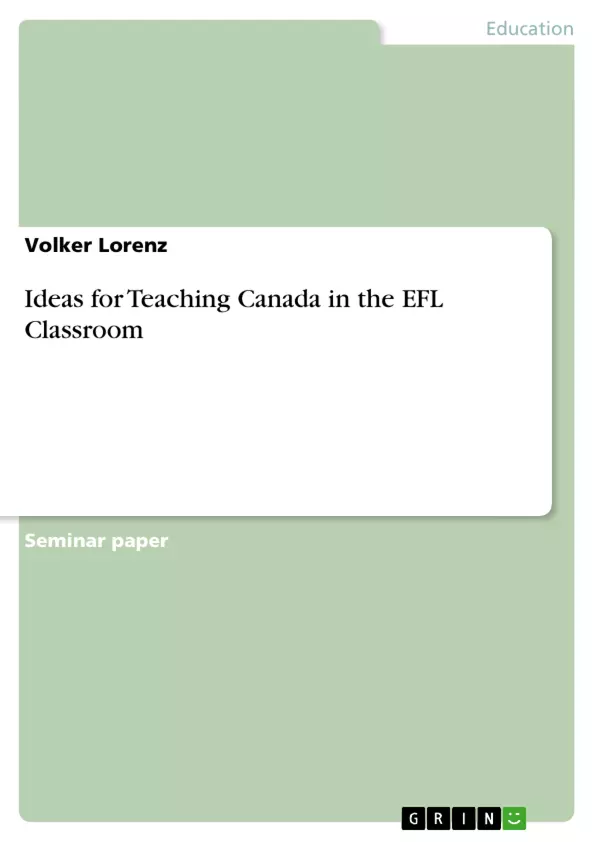Several current curricula for the German secondary EFL classroom (Rahmenrichtlinien) now include some of the so-called new English cultures, like Australia, New Zealand, and Canada. Especially Canada, considering its geographical and cultural proximity to the nowadays almost omnipresent USA, presents itself as a natural addition to the “traditional” Anglophone cultures.
I argue in favour of a didactic approach not only via history, geography, or any other specific ‘Cultural’ aspect alone, but via a mixture of both ‘big c’ Culture and ‘small c’ culture using a selection of different authentic media and texts.
Inhaltsverzeichnis (Table of Contents)
- 1. A GLANCE AT CULTURAL STUDIES
- 2. INTRODUCING CANADA – CONSIDERATIONS IN ADVANCE
- 3. ELEMENTS OF AN EXEMPLARY INSTRUCTIONAL UNIT
- 3.1 INTRODUCING THE TOPIC
- 3.2 A LITERARY BASIS
- 3.3 DEALING WITH NEW MEDIA
- 3.4 RE-THINKING STEREOTYPES
- 3.5 CHRISTMAS ‘SMALL C' CULTURE: BOB & DOUG MCKENZIE
- 3.6 MULTICULTURALISM AND CANADA'S EXEMPLARY STATUS
- 3.7 TESTING THE LEARNERS' KNOWLEDGE AND SKILLS
- 4. A MODEL SYLLABUS
- 5. REFERENCES
Zielsetzung und Themenschwerpunkte (Objectives and Key Themes)
This paper outlines ideas for teaching Canada within an EFL classroom. It highlights the shift from traditional Landeskunde to a more culturally sensitive approach based on cultural studies. The paper emphasizes the importance of fostering intercultural competence and exploring different aspects of Canadian culture, both ‘big C' and ‘small c'.
- Introducing Cultural Studies in the EFL classroom
- Developing intercultural competence in learners
- Teaching Canada as a new English culture
- Exploring Canadian culture through diverse media and texts
- Re-thinking stereotypes and their role in understanding other cultures
Zusammenfassung der Kapitel (Chapter Summaries)
- Chapter 1: The chapter introduces the concept of Cultural Studies and its application in the EFL classroom. It discusses the importance of intercultural learning and highlights the shift from a fact-based approach to a more nuanced understanding of target cultures.
- Chapter 2: This chapter focuses on considerations for introducing Canada in an EFL setting. It emphasizes the importance of selecting aspects of both ‘big C' and ‘small c' culture and utilizing a variety of authentic media and texts to engage learners.
- Chapter 3: This chapter delves into elements of an exemplary instructional unit for teaching Canada. It offers concrete examples of activities and materials, including introducing the topic, exploring literature, dealing with new media, and re-thinking stereotypes.
Schlüsselwörter (Keywords)
The main keywords of this paper include Cultural Studies, intercultural competence, EFL classroom, teaching Canada, new English cultures, ‘big C' culture, ‘small c' culture, authentic media, stereotypes, and critical analysis.
- Citar trabajo
- Volker Lorenz (Autor), 2007, Ideas for Teaching Canada in the EFL Classroom, Múnich, GRIN Verlag, https://www.grin.com/document/93543



